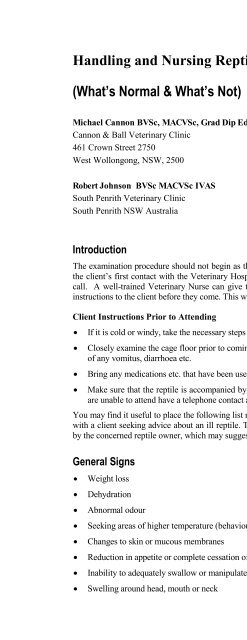Handling and Nursing Reptiles - Australian Veterinary Association
Handling and Nursing Reptiles - Australian Veterinary Association
Handling and Nursing Reptiles - Australian Veterinary Association
Create successful ePaper yourself
Turn your PDF publications into a flip-book with our unique Google optimized e-Paper software.
<strong>H<strong>and</strong>ling</strong> <strong>and</strong> <strong>Nursing</strong> <strong>Reptiles</strong><br />
(What’s Normal & What’s Not)<br />
Michael Cannon BVSc, MACVSc, Grad Dip Ed<br />
Cannon & Ball <strong>Veterinary</strong> Clinic<br />
461 Crown Street 2750<br />
West Wollongong, NSW, 2500<br />
Robert Johnson BVSc MACVSc IVAS<br />
South Penrith <strong>Veterinary</strong> Clinic<br />
South Penrith NSW Australia<br />
Introduction<br />
The examination procedure should not begin as the client walks into the consulting room, but with<br />
the client’s first contact with the <strong>Veterinary</strong> Hospital – in most cases this will be with a telephone<br />
call. A well-trained <strong>Veterinary</strong> Nurse can give this procedure a good foundation by giving clear<br />
instructions to the client before they come. This will help make the examination more fruitful.<br />
Client Instructions Prior to Attending<br />
<br />
<br />
<br />
<br />
If it is cold or windy, take the necessary steps to protect the reptile.<br />
Closely examine the cage floor prior to coming in. Bring in the cage floor covering or a sample<br />
of any vomitus, diarrhoea etc.<br />
Bring any medications etc. that have been used.<br />
Make sure that the reptile is accompanied by someone who knows the current history. If they<br />
are unable to attend have a telephone contact available, or provide a detailed written history.<br />
You may find it useful to place the following list near the telephone for you or your nurse to discuss<br />
with a client seeking advice about an ill reptile. The list includes clinical signs, easily recognisable<br />
by the concerned reptile owner, which may suggest significant problems for the reptile:<br />
General Signs<br />
<br />
<br />
<br />
<br />
<br />
<br />
<br />
<br />
Weight loss<br />
Dehydration<br />
Abnormal odour<br />
Seeking areas of higher temperature (behavioural fever)<br />
Changes to skin or mucous membranes<br />
Reduction in appetite or complete cessation of eating<br />
Inability to adequately swallow or manipulate food within the mouth<br />
Swelling around head, mouth or neck

















